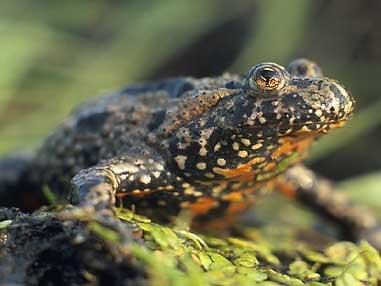
Bombina bombina (Source)
Superregnum: Eukaryota
Regnum: Animalia
Subregnum: Eumetazoa
Cladus: Bilateria
Cladus: Nephrozoa
Superphylum: Deuterostomia
Phylum: Chordata
Cladus: Craniata
Subphylum: Vertebrata
Infraphylum: Gnathostomata
Superclassis: Tetrapoda
Classis: Amphibia
Subclassis: Lissamphibia
Ordo: Anura
Familia: Bombinatoridae
Genus: Bombina
Species: Bombina bombina
Name
Bombina bombina (Linnaeus, 1761)
Type locality: "Scaniae compestris fossis australibus".
Holotype: Alströmer collection, which now belongs to the ZIUU.
Synonyms
Rana bombina Linnaeus, 1761
Bufo igneus Laurenti, 1768
Buffo ignicolor Lacépède, 1788
Bufo bombinus — Latreille in Sonnini de Manoncourt & Latreille, 1801
Rana ignea — Shaw, 1802
Bufo pluvialis Daudin, 1802
Rana cruenta Pallas, 1814
Bombinator igneus — Merrem, 1820
Bombina ignea — Sturm, 1828
Bufo (Bombinator) bombina — Cuvier, 1829
Bombitator bombinus — Wagler, 1830
Bufo cruentus — Dvigubsky, 1832
Bufo bombinus — Schinz, 1833
Bufo bombina — Schinz, 1837
Bombinator igneus — Boulenger, 1882
Bombinator bombina — Bedriaga, 1890
Bombinator variegatus bombina — Prazák, 1898
Bombina bombina — Stejneger, 1907
Bombina bombina danubialis Calinescu, 1931
Bombina bombina var. viridis Marián, 1959
Bombina (Bombina) bombina — Tian & Hu, 1985
Bombina bombina arifiyensi Özeti & Yilmaz, 1987
References
Linnaeus, 1761, Fauna Svec.: 101.
Stejneger, 1907, Bull. U.S. Natl. Mus., 58: 51.
Frost, D.R. 2021. Amphibian Species of the World: an Online Reference. Version 6.1. Electronic Database accessible at https://amphibiansoftheworld.amnh.org/index.php. American Museum of Natural History, New York, USA. DOI: 10.5531/db.vz.0001 Bombina bombina . Accessed on 14 July 2008.
2007 IUCN Red List of Threatened Species IUCN: Bombina bombina (Least Concern) Downloaded on 14 July 2008.
Vernacular names
беларуская: Жарлянка чырванабрухая
čeština: Kuňka obecná
Deutsch: Rotbauchunke
English: Firebelly Toad
español: Sapillo de vientre rojo europeo
français: Sonneur à ventre de feu
magyar: Vöröshasú unka
italiano: Ululone dal ventre rosso
日本語: ヨーロッパスズガエル
lietuvių: Raudonpilvė kūmutė
Nederlands: Roodbuikvuurpad
polski: Kumak nizinny
Türkçe: Kızılca kurbağa
The European fire-bellied toad (Bombina bombina) is a fire-bellied toad native to mainland Europe. Other common names used for the European fire-bellied toad include ringing frog, fiery toad, fire frog, and firebelly toad. It is a popular pet due to its bright colored belly.
Description
European fire-bellied toads have a bright lime green dorsal traversed by black spots, and orange to bright red bellies with black bars and stripes. The skin is mildly bumpy, the eyes set high to suit a semi-aquatic life style, and also well webbed back feet. Color and body variations will be described for each of the other 3 species commonly sold as or mistaken for Oriental fire-bellied toads. They are the largest of the bombina family. They are commonly darker than Fire-bellied toads from Asia.
The European fire-bellied toad is 26–60 mm long and may weigh 2-13.9 g. The body is depressed. Above, the skin is densely covered in low tubercles with black horny spines. There are no parotids behind the eyes but paired and arched gland complexes at the neck. The eardrums are not visible. Inner vocal sacs are present at the throat and webbings are well developed at the hind feet. The pupils are heart-shaped. The body colour is grey, brown or green with dark spots on the upper side and blackish with larger orange or red and smaller white spots on the underside. The skin produces a poison to protect itself from bacteria and fungi or the animal from vertebrates. This poison is irritating to mucous membranes. The eggs are brown above and lighter below. They are 1.4-1.8 mm large coated with a transparent jelly of 5–8 mm in diameter. Tadpoles may reach a length of 55 mm and are brownish above with two longitudinal pale bands along the backbone. The mouth field is triangular and the flipper is reticulated.
When they shed their skin, they bloat themselves and make a coughing sound, then start to tear the old skin off with their mouth, and eat it for nutrition, to reveal newer, brighter skin.
Diet
The food of the European fire-bellied toad consists of insects, spiders, millipedes, mollusks and earthworms captured in or nearby the water. The tadpoles mainly feed on algae, bacteria and plankton by grazing the surfaces of stones and plants. If attacked by a vertebrate on land the European fire-bellied toad makes a hollow-back and lifts its four legs so that the ventral warning colour is displayed. The combination of dark and red is a learned signal meaning “attention poison” to the enemy.
Reproduction
Reproduction takes place from April to July/August and is induced by heavy rainfall. Then, males can be recognized by some darkened, spiny swelling, the nuptial pad, on their forelegs. They help it to grasp the female properly around its hip. Males defend small territories of 2–3 m in diameter against rivals. Spawn consists of small clutches of 10–40 eggs which are attached to plants. Several such clutches are produced in a short time and thereby a female may lay a total of 80–300 eggs. Tadpoles hatch after 2–5 days and metamorphose after 5–12 weeks from July to September or after hibernation in spring. Young toads are 11–15 mm long and remain at the water's edge. Maturity is reached at an age of 1–2 years. The European fire-bellied toad may live more than 10 years. The rather loud melodic call is repeated about 10–50 times per minute, correlating with temperature, and is performed in the afternoon at temperatures of 12–34 °C while drifting at the water surface. The sound is produced when the air is pressed from the vocal sac back to the lungs which is the opposite to what “higher” frogs do. It hibernates on land in frost-resisting dens like hollows under stones or dead wood.
References
Aram Agasyan, Aziz Avisi, Boris Tuniyev, Jelka Crnobrnja Isailovic, Petros Lymberakis, Claes Andrén, Dan Cogalniceanu, John Wilkinson, Natalia Ananjeva, Nazan Üzüm, Nikolai Orlov, Richard Podloucky, Sako Tuniyev, Uğur Kaya (2009). "Bombina bombina". IUCN Red List of Threatened Species. 2009: e.T2865A9489517. doi:10.2305/IUCN.UK.2009.RLTS.T2865A9489517.en. Retrieved 11 November 2021.
Retrieved from "http://en.wikipedia.org/"
All text is available under the terms of the GNU Free Documentation License

